9.3: Drawing Lewis Structures
- Page ID
- 170032
\( \newcommand{\vecs}[1]{\overset { \scriptstyle \rightharpoonup} {\mathbf{#1}} } \)
\( \newcommand{\vecd}[1]{\overset{-\!-\!\rightharpoonup}{\vphantom{a}\smash {#1}}} \)
\( \newcommand{\id}{\mathrm{id}}\) \( \newcommand{\Span}{\mathrm{span}}\)
( \newcommand{\kernel}{\mathrm{null}\,}\) \( \newcommand{\range}{\mathrm{range}\,}\)
\( \newcommand{\RealPart}{\mathrm{Re}}\) \( \newcommand{\ImaginaryPart}{\mathrm{Im}}\)
\( \newcommand{\Argument}{\mathrm{Arg}}\) \( \newcommand{\norm}[1]{\| #1 \|}\)
\( \newcommand{\inner}[2]{\langle #1, #2 \rangle}\)
\( \newcommand{\Span}{\mathrm{span}}\)
\( \newcommand{\id}{\mathrm{id}}\)
\( \newcommand{\Span}{\mathrm{span}}\)
\( \newcommand{\kernel}{\mathrm{null}\,}\)
\( \newcommand{\range}{\mathrm{range}\,}\)
\( \newcommand{\RealPart}{\mathrm{Re}}\)
\( \newcommand{\ImaginaryPart}{\mathrm{Im}}\)
\( \newcommand{\Argument}{\mathrm{Arg}}\)
\( \newcommand{\norm}[1]{\| #1 \|}\)
\( \newcommand{\inner}[2]{\langle #1, #2 \rangle}\)
\( \newcommand{\Span}{\mathrm{span}}\) \( \newcommand{\AA}{\unicode[.8,0]{x212B}}\)
\( \newcommand{\vectorA}[1]{\vec{#1}} % arrow\)
\( \newcommand{\vectorAt}[1]{\vec{\text{#1}}} % arrow\)
\( \newcommand{\vectorB}[1]{\overset { \scriptstyle \rightharpoonup} {\mathbf{#1}} } \)
\( \newcommand{\vectorC}[1]{\textbf{#1}} \)
\( \newcommand{\vectorD}[1]{\overrightarrow{#1}} \)
\( \newcommand{\vectorDt}[1]{\overrightarrow{\text{#1}}} \)
\( \newcommand{\vectE}[1]{\overset{-\!-\!\rightharpoonup}{\vphantom{a}\smash{\mathbf {#1}}}} \)
\( \newcommand{\vecs}[1]{\overset { \scriptstyle \rightharpoonup} {\mathbf{#1}} } \)
\( \newcommand{\vecd}[1]{\overset{-\!-\!\rightharpoonup}{\vphantom{a}\smash {#1}}} \)
\(\newcommand{\avec}{\mathbf a}\) \(\newcommand{\bvec}{\mathbf b}\) \(\newcommand{\cvec}{\mathbf c}\) \(\newcommand{\dvec}{\mathbf d}\) \(\newcommand{\dtil}{\widetilde{\mathbf d}}\) \(\newcommand{\evec}{\mathbf e}\) \(\newcommand{\fvec}{\mathbf f}\) \(\newcommand{\nvec}{\mathbf n}\) \(\newcommand{\pvec}{\mathbf p}\) \(\newcommand{\qvec}{\mathbf q}\) \(\newcommand{\svec}{\mathbf s}\) \(\newcommand{\tvec}{\mathbf t}\) \(\newcommand{\uvec}{\mathbf u}\) \(\newcommand{\vvec}{\mathbf v}\) \(\newcommand{\wvec}{\mathbf w}\) \(\newcommand{\xvec}{\mathbf x}\) \(\newcommand{\yvec}{\mathbf y}\) \(\newcommand{\zvec}{\mathbf z}\) \(\newcommand{\rvec}{\mathbf r}\) \(\newcommand{\mvec}{\mathbf m}\) \(\newcommand{\zerovec}{\mathbf 0}\) \(\newcommand{\onevec}{\mathbf 1}\) \(\newcommand{\real}{\mathbb R}\) \(\newcommand{\twovec}[2]{\left[\begin{array}{r}#1 \\ #2 \end{array}\right]}\) \(\newcommand{\ctwovec}[2]{\left[\begin{array}{c}#1 \\ #2 \end{array}\right]}\) \(\newcommand{\threevec}[3]{\left[\begin{array}{r}#1 \\ #2 \\ #3 \end{array}\right]}\) \(\newcommand{\cthreevec}[3]{\left[\begin{array}{c}#1 \\ #2 \\ #3 \end{array}\right]}\) \(\newcommand{\fourvec}[4]{\left[\begin{array}{r}#1 \\ #2 \\ #3 \\ #4 \end{array}\right]}\) \(\newcommand{\cfourvec}[4]{\left[\begin{array}{c}#1 \\ #2 \\ #3 \\ #4 \end{array}\right]}\) \(\newcommand{\fivevec}[5]{\left[\begin{array}{r}#1 \\ #2 \\ #3 \\ #4 \\ #5 \\ \end{array}\right]}\) \(\newcommand{\cfivevec}[5]{\left[\begin{array}{c}#1 \\ #2 \\ #3 \\ #4 \\ #5 \\ \end{array}\right]}\) \(\newcommand{\mattwo}[4]{\left[\begin{array}{rr}#1 \amp #2 \\ #3 \amp #4 \\ \end{array}\right]}\) \(\newcommand{\laspan}[1]{\text{Span}\{#1\}}\) \(\newcommand{\bcal}{\cal B}\) \(\newcommand{\ccal}{\cal C}\) \(\newcommand{\scal}{\cal S}\) \(\newcommand{\wcal}{\cal W}\) \(\newcommand{\ecal}{\cal E}\) \(\newcommand{\coords}[2]{\left\{#1\right\}_{#2}}\) \(\newcommand{\gray}[1]{\color{gray}{#1}}\) \(\newcommand{\lgray}[1]{\color{lightgray}{#1}}\) \(\newcommand{\rank}{\operatorname{rank}}\) \(\newcommand{\row}{\text{Row}}\) \(\newcommand{\col}{\text{Col}}\) \(\renewcommand{\row}{\text{Row}}\) \(\newcommand{\nul}{\text{Nul}}\) \(\newcommand{\var}{\text{Var}}\) \(\newcommand{\corr}{\text{corr}}\) \(\newcommand{\len}[1]{\left|#1\right|}\) \(\newcommand{\bbar}{\overline{\bvec}}\) \(\newcommand{\bhat}{\widehat{\bvec}}\) \(\newcommand{\bperp}{\bvec^\perp}\) \(\newcommand{\xhat}{\widehat{\xvec}}\) \(\newcommand{\vhat}{\widehat{\vvec}}\) \(\newcommand{\uhat}{\widehat{\uvec}}\) \(\newcommand{\what}{\widehat{\wvec}}\) \(\newcommand{\Sighat}{\widehat{\Sigma}}\) \(\newcommand{\lt}{<}\) \(\newcommand{\gt}{>}\) \(\newcommand{\amp}{&}\) \(\definecolor{fillinmathshade}{gray}{0.9}\)Learning Objectives
- To draw Lewis Structures for molecules and polyatomic ions with one central atom.
Introduction to Lewis structures
A Lewis structure is a way to show how atoms share electrons when they form a molecule. Lewis structures show all of the valence electrons in an atom or molecule. The valence electrons are the electrons in the outermost shell. For representative elements, the number of valence electrons equals the group number on the periodic table. To draw the Lewis structure of an atom, write the symbol of the atom and draw dots around it to represent the valence electrons.

Note that hydrogen is often shown in both group 1A and group 7A, but it has one valence electron – never seven. Also, helium is shown in group 8A, but it only has two valence electrons.
Representing a Covalent Bond Using Lewis Structures
Nonmetals can form a chemical bond by sharing two electrons. Each atom contributes one electron to the bond. For example, two hydrogen atoms can form a bond, producing a molecule of H2. Using Lewis structures, we can represent this as follows:

Two fluorine atoms can form a molecule of F2 in the same fashion. Note that each atom must contribute one electron to the bond.

Atoms can form more than one bond. In a water molecule, an oxygen atom forms two bonds, one to each hydrogen atom.

Chemists normally represent a bond using a line instead of two dots. The structures of H2, F2, and H2O would usually be drawn as follows:

Only the bonding electrons are shown using lines. Nonbonding electrons are always shown using dots.
Multiple Bonds
The bonds on the previous section are called single bonds. Each bond contains two electrons (one bonding pair). A pair of atoms can also share four electrons or six electrons. If the atoms share four electrons, the bond is called a double bond. For example, the bond in O2 is a double bond.

A double bond is normally depicted with two parallel lines.

If the atoms share six electrons, the bond is called a triple bond. Triple bonds are rather rare, but the bond in N2 is a triple bond.

A triple bond is depicted with three parallel lines.

Drawing Lewis structures for molecules with one central atom: two rules
In Chem 101A, we will focus on drawing Lewis structures of molecules and polyatomic ions that have one central atom with several other atoms attached to it. Such molecules are very common, and they provide a foundation for understanding structures of more complex molecules. To begin, you must know two essential rules for drawing Lewis structures.
Rule 1: In any molecule or ion with the general formula ABn , the unique atom (A) is in the center and all of the B atoms are attached to A.
For example, the basic arrangements of the atoms in SO3, NH4+, and PCl5 are:

Do not ever draw a structure like the ones below!

Rule 2: Lewis structures are not intended to show the actual shape of the molecule; they only show which atoms are bonded to each other.
None of the molecules above actually look like the structures here. For example, the actual shape of SO3 is:

Drawing Lewis structures for molecules with one central atom: five steps to success
The following procedure will give you the correct Lewis structure for any molecule or polyatomic ion that has one central atom.
Step 1: Figure out how many electrons the molecule must have, based on the number of valence electrons in each atom. When drawing the structure of an ion, be sure to add/subtract electrons to account for the charge.
Step 2: Connect the atoms to each other with single bonds to form a “skeleton structure.” Be sure that you follow rule 1 in the previous section.
Step 3: Add enough electrons (dots) to the outer atoms to give each of them a total of eight electrons around them. (Exception: do not add electrons to hydrogen atoms.) This tendency of atoms to have eight electrons around them is called the octet rule.
Step 4: Count the electrons in your structure. If you need to add any more based on your count in step 1, add them to the central atom. The electron count in your final answer must match the count from step 1.
Step 5:
- If the central atom has 8 or more electrons around it, you’re finished.
- If the central atom has fewer than 8 electrons around it, but all of the surrounding atoms are from group 7A, you’re finished.
- Otherwise, move a nonbonding electron pair from an outer atom to a bond (i.e. make a double bond). If the central atom now has 8 electrons around it, you’re finished. Otherwise, repeat this process until the central atom has 8 electrons.
Example: drawing the Lewis structure of CO32–
Step 1) Figure out how many electrons the molecule must have.
Carbon has 4 valence electrons
Each oxygen has 6 valence electrons
The -2 charge means that there are 2 extra electrons
Total: 4 + (3 × 6) + 2 = 24 electrons
The final answer MUST have this number of electrons‼!
Step 2) Attach the atoms to each other using single bonds (“draw the skeleton structure”)

Step 3) Add electrons to all outer atoms (except H) to complete their octets.
The outer atoms are the oxygen atoms here. Each outer atom needs three electron pairs, since it already has one bonding pair.
(1 line = 2 electrons)

Step 4) Count the electrons in the structure.
This structure has 24 electrons.
3 lines = 6 bonding electrons
18 dots = 18 nonbonding electrons
total = 24 electrons
Does this match the count you got in step 1?
CO32–: should have 24 electrons (from step 1)
Our structure has 24 electrons – check! It MATCHES!
Step 5)
If the central atom has 8 or more electrons, you’re done.
The carbon atom has only 6 electrons around it, so we aren’t finished yet…
If the central atom has fewer than 8 electrons, but all of the outer atoms are in group 7A, you’re done.
The outer atoms are oxygen atoms, and oxygen is in group 6A, so we aren’t finished yet…
Otherwise, create an extra bond by changing one of the nonbonding pairs into a bonding pair. (Exception: don’t do this if all of the outer atoms are from group 7A.)

Notice that this step does not change the total number of electrons in our structure. It just moves 2 electrons to a different location.
If the central atom still has fewer than 8 electrons around it, do this as many more times as you need. But do not go beyond 8 electrons on the central atom. When you reach 8 electrons, you’re done.
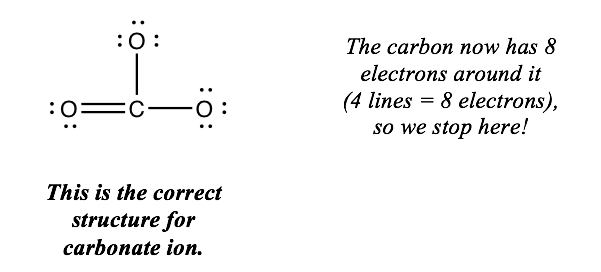
Chemists often draw square brackets around the structure of a polyatomic ion and write the charge outside the brackets, like this:

Note: we could have put the double bond in two other locations. Any of the three options is fine; you only need to draw one of them.
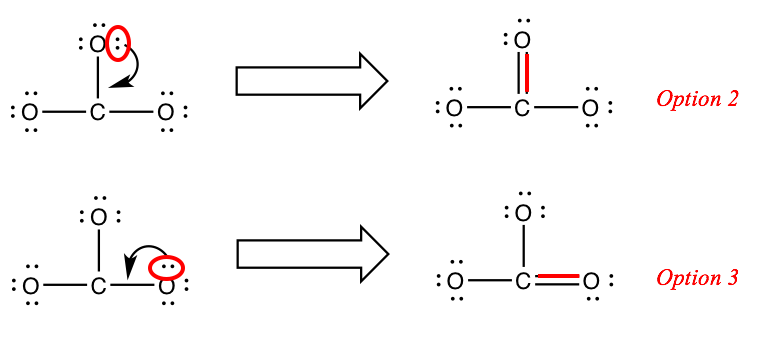
(If you’re wondering “what about resonance??”… we’ll get to that later on.)
Example: Drawing Lewis structures for BF3, PF3 and BrF3
Next, we’ll look at three molecules side-by-side. The molecules are BF3, PF3, and BrF3, all of which have a central atom bonded to three fluorine atoms.
Step 1) Figure out how many electrons each molecule must have.
BF3: 3 + 7 + 7 + 7 = 24 electrons
PF3: 5 + 7 + 7 + 7 = 26 electrons
BrF3: 7 + 7 + 7 + 7 = 28 electrons
The final answers MUST have these numbers of electrons‼!
Step 2) Attach the atoms to each other using single bonds (“draw the skeleton structure”).

Step 3) Add electrons to the outer atoms, to complete their octets.
Each outer atom needs three electron pairs.
Step 4) Count the electrons in each structure.
Each of these structures has 24 electrons.
3 lines = 6 bonding electrons
18 dots = 18 nonbonding electron
total = 24 electrons
Do these match the counts you got in step 1?
BF3: should have 24 electrons (from step 1)
Our structure has 24 electrons – MATCHES
PF3: should have 26 electrons (from step 1)
Our structure has 24 electrons
WE NEED TO ADD 2 MORE ELECTRONS
BrF3: should have 28 electrons (from step 1)
Our structure has 24 electrons
WE NEED TO ADD 4 MORE ELECTRONS
If the counts do not match, add the remaining electrons to the central atom.

Step 5) If the central atom has 8 or more electrons around it, you’re done.
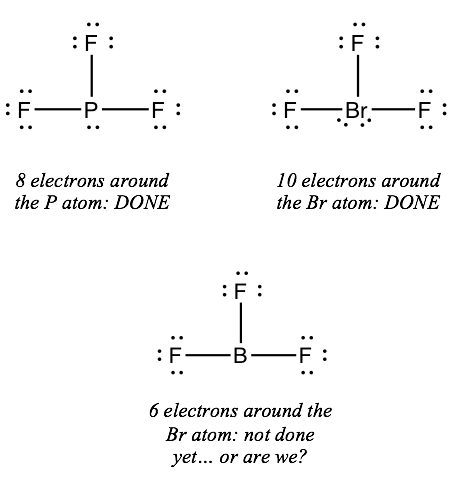
If the central atom has fewer than 8 electrons around it, but all of the outer atoms are in group 7A, you’re done
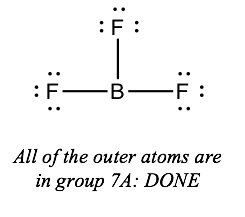
Note: these six elements from group 7A are called halogens: F, Cl, Br, I At, Tn. You’ll only see the first four of them in chemical compounds; the last two are extremely radioactive.
Breaking the Octet Rule
The central atom in a structure often violates the octet rule. Electron-deficient atoms are rare, but expanded octets are fairly common with elements in the 3rd row and beyond.
In BF3, the central atom only has 6 electrons around it. We say that the boron atom is electron deficient.
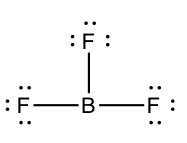
In BrF3, the central atom has 10 electrons around it. We say that the bromine atom has an expanded octet.
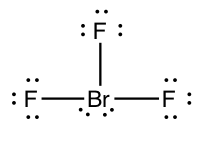
Note that it is also quite common for the central atom to make more than four bonds. Here are a couple of examples:
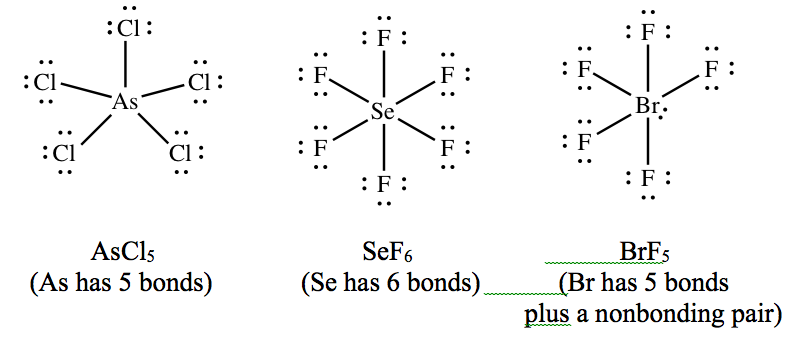
Don’t panic if you see such molecules. Just follow the rules for drawing Lewis structures, and you’ll get them right! However, you must note that outer atoms never violate the octet rule.
Using formal charges to determine how many bonds to make, a different perspective...
If we draw the Lewis structure for PO43– ion using the rules you’ve seen earlier, we come up with the structure below. It has the correct number of electrons (32), and every atom satisfies the octet rule.

However, many textbooks (and websites) insist that the structure below is a better one, even though the phosphorus atom has ten electrons around it:
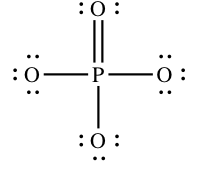
The first structure follows the rules for drawing structures. So why do chemists add a double bond? To understand, we need the formal charges on the atoms in each structure…

Many chemists prefer the second structure because it gives us a couple of zeroes. However, the phosphorus atom in the second structure violates the octet rule. So which structure is best?? The answer is that either structure is legitimate. Both structures give us all of the information we need about phosphate ion; they allow us to predict the shape of the molecule, the angles between the bonds, and whether the molecule is polar.
So which structure should YOU draw on a test? Be sure to check with your instructor, but most will accept either one. However, the first structure is easier to figure out, because it’s the structure you produce when you follow the provided rules. The second structure requires more work. Therefore, we recommend that when you draw a structure that satisfies the octet rule, you stop there without adding more bonds.
WARNING: Some students come to Chem 101A having been taught to draw Lewis structures with extra double bonds.
If you’re familiar with Lewis structures and you like the extra bonds… congratulations! You have less to learn – you already know all of this stuff.
BUT…
If you draw structures with extra bonds, they have to be correct. For example, a structure for phosphate that has two double bonds is not acceptable.

Also, a structure for nitrate ion (NO3–) that has two double bonds is not acceptable, even though it gives you more zeroes. The structure with one double bond is the only acceptable one.

If you don’t know why the structures I’ve labeled “unacceptable” are not allowed, don’t risk losing points by adding extra bonds when the central atom already has eight electrons.
Using formal charges to evaluate which is the best central atom...
Generally, you are told which atom is the central bonding atom in the molecule. However, if it is unclear, or if you are asked to decide which atom is central, formal charges can be used to decide. The following is an example.
Example: calculating the formal charges in HCN and HNC
For the arrangement HCN, the Lewis structure: H–C\(\equiv\)N:
The formal charges work out as follows:

For the arrangement HNC, the Lewis structure: H–N\(\equiv\)C:
The formal charges work out as follows:

Both Lewis structures have a net formal charge of zero, but note that the formal charges on the first structure are all zero! Thus the first Lewis structure is predicted to be more stable, and it is, in fact, the structure observed experimentally. In general, the closer the formal charges are to zero, the more stable the structure. Remember, though, that formal charges do not represent the actual charges on atoms in a molecule or ion. They are used simply as a book-keeping method for predicting the most stable Lewis structure for a compound.
Summary
References
Contributors and Attributions
James Armstrong, City College of San Francisco
Torrey Glenn, City College of San Francisco

